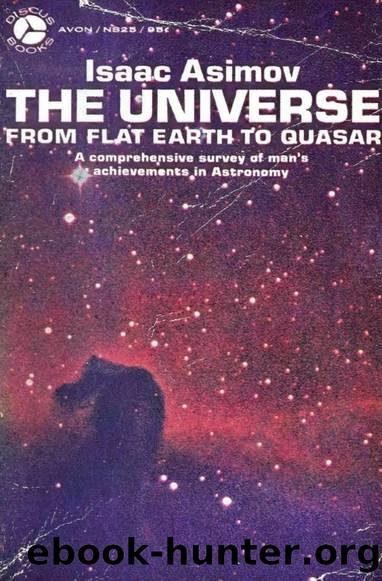The Universe: From Flat Earth to Quasar by Isaac Asimov

Author:Isaac Asimov [Asimov, Isaac]
Language: eng
Format: epub
ISBN: 9780380421923
Amazon: B000AN3J82
Published: 2022-11-12T09:34:08+00:00
Stellar Explosions
16?
Sun, or less. In 1895, the German-American astronomer John Martin Schaeberle (1853-1924) detected Procyon B
and that turned out to be only of the eleventh magnitude.
Even allowing for the fact that Procyon B was a bit farther from us than Sirius B, it could quickly be shown that Procyon B was even dimmer than Sirius B Such stars might not be completely dark, but they were certainly dwarf stars.
It was taken rather for granted at the turn of the century that stars like Sirius B and Procyon B were dying stars that were dim primarily because the stellar fires were flickering out. One might suppose that such stars might fit neatly among the red dwarfs at the tail of the main sequence.
However, even as the H-R diagram was being worked out, it became quite apparent that Sirius B, for instance, would not fit in just that place. To be at the tail end of the main sequence, a star would have to be very cool, and, therefore, a deep red in color. Sirius B, however, was not red. It shone with a clear white light. If it was a dwarf, it was a âwhite dwarf.â
In 1914, the American astronomer Walter Sydney Adams (1876-1956) succeeded in taking the spectrum of Sirius B and found it to be a spectral class A star, exactly as Sirius A itself was. This meant that Sirius B had to have a surface temperature as high as that of Sirius A (10,000° C.) and higher than the mere 6000° C. surface temperature of the Sun.
But if Sirius B was hotter than the Sun, it should have a surface brighter than the Sun, square mile for square mile.
The fact that Sirius B was so much less luminous than the Sun could only mean that Sirius B possessed very few square miles of surface area. It was a star that was white-hot but very small, just the kind of star you would expect to find in the lower left region of the H-R diagram, the region mentioned at the end of the previous chapter.
In fact, it would have to be quite small. To account for its dimness, Sirius B would have to have a diameter of not more than 17,000 miles and be no larger in size than the planet Uranus. It would be a white dwarf indeed.
And yet Sirius B would still have the mass of the Sun.
That was determined from the gravitational effect of Sirius B on Sirius A, and it could not be argued away. For a star, then, to be as small as Uranus and as massive as the Sun brought up serious questions of densityâquestions that would have raised insuperable difficulties in the nine
Download
This site does not store any files on its server. We only index and link to content provided by other sites. Please contact the content providers to delete copyright contents if any and email us, we'll remove relevant links or contents immediately.
| Aeronautics & Astronautics | Astronomy |
| Astrophysics & Space Science | Comets, Meteors & Asteroids |
| Cosmology | Mars |
| Solar System | Star-Gazing |
| Telescopes | UFOs |
Tools of Titans by Timothy Ferriss(8304)
Turbulence by E. J. Noyes(7978)
Secrets of Antigravity Propulsion: Tesla, UFOs, and Classified Aerospace Technology by Ph.D. Paul A. Laviolette(5333)
Astrophysics for People in a Hurry by Neil DeGrasse Tyson(5151)
Room 212 by Kate Stewart(5071)
Design of Trajectory Optimization Approach for Space Maneuver Vehicle Skip Entry Problems by Runqi Chai & Al Savvaris & Antonios Tsourdos & Senchun Chai(5037)
Pale Blue Dot by Carl Sagan(4954)
The David Icke Guide to the Global Conspiracy (and how to end it) by David Icke(4657)
A Journey Through Divination and Astronomy by Publishing Pottermore(4363)
Goodbye Paradise(3761)
Apollo 8 by Jeffrey Kluger(3668)
COSMOS by Carl Sagan(3589)
The Five People You Meet in Heaven by Mitch Albom(3520)
Losing the Nobel Prize by Brian Keating(3518)
How to Read Water: Clues and Patterns from Puddles to the Sea (Natural Navigation) by Tristan Gooley(3433)
Brief Answers to the Big Questions by Stephen Hawking(3393)
How to Read Nature by Tristan Gooley(3292)
The Order of Time by Carlo Rovelli(3162)
A Brief History of Time by Stephen Hawking(2992)
